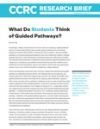
Based at the Teachers College of Columbia University, the Community College Research Center (CCRC) conducts research on the issues affecting community colleges and works with colleges and states to improve student success and institutional performance. In July 2017, the CCRC released a new ten page research brief titled What Do Students Think of Guided Pathways?. In this report, 149 students at the City Colleges of Chicago (CCC) were interviewed about their experiences with a new guided pathway tool and how it has influenced their studies, their plans for the future, and whether or not it’s actually helping them stay on track in terms of their educational goals.
The use of guided pathways involves re-thinking academic programs and support services for students with four objectives in mind:
- mapping pathways to student end-goals
- helping students choose and enter a program pathway
- keeping students on their pathway to completion
- ensuring that students are learning throughout their programs
In 2010, the CCC rolled out a new approach to their guided-pathway system: using Smart Planner, on online tool which was a significant change from the previous process of pen, paper, and periodic meetings with the students’ advisors. A major reason for implementing this new guided pathway system was to help students enter and complete a program of study as quickly as possible, in addition to laying a solid foundation which could support future educational endeavors and employment. Within five years of implementing Smart Planner, CCC’s graduation rates increased by 10%.
The majority of students interviewed expressed a great deal of enthusiasm about the new process. Smart Planner contains a program map unique to each student, showing where they are in their academic pathway and what courses are needed to complete their degree, in addition to a variety of other resources. Many students felt that the resources available to them increased their confidence and motivation to make progress toward completion. Among the most useful features, according to the students interviewed, is the program’s ability to clarify degree requirements and help them to figure out which courses counted toward degree completion and/or if they’re transferable to another college.
Not all students felt as comfortable with the new system - some expressed concern with technical difficulties they experienced at the beginning of the roll-out and some students felt overwhelmed by the idea of having to plan out their degree pathway so far ahead of time.
For those of us in the ATE Community this research brief could prove to be useful in a number of ways:
- Use the report data to help support the needs section in a grant proposal
- Encourage the re-evaluation of your own institution's current guided pathway system for effectiveness
- Utilize the real-life examples of how an online guided pathway system can impact students’ experience in reports, grants, or presentations

 Subscribe
Subscribe


 See More ATE Impacts
See More ATE Impacts

Comments
There are no comments yet for this entry. Please Log In to post one.